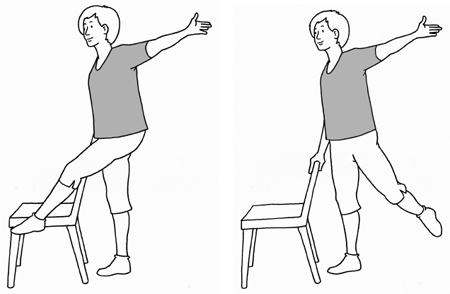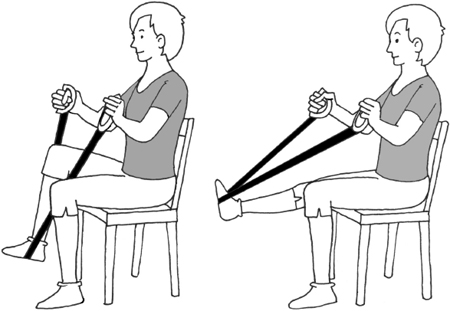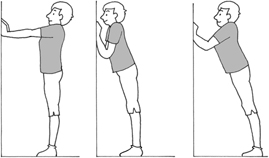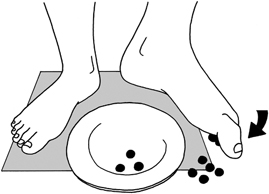
Maintaining good balance
Having a good sense of balance helps us to remain physically independent as the years go by. Good balance enables us to walk without staggering, bend over without falling, climb stairs without tripping and get up from a chair unaided. As we age, some of us are likely to have problems with balance, but these problems do not occur because of age. For example, some balance disorders are caused by problems of the inner ear, when the labyrinth becomes infected or swollen (labyrinthitis). Low blood pressure can cause dizziness, and Ménière’s disease of the middle ear causes vertigo, poor balance and hearing problems. Other balance disorders may involve a head injury or a disorder in another part of the body, such as the brain or the heart. Diseases of the circulatory system, such as stroke, can cause dizziness, while smoking and diabetes increases the risk of stroke.
In some cases, you can help reduce your risk of balance problems. An unsteady balance due to high blood pressure can be managed by eating less salt (sodium), maintaining a healthy weight and exercising. Some medicines, such as those taken to help lower blood pressure, can affect the balance mechanisms in your ears and you may feel dizzy. These include some antidepressants, sedatives, tranquillisers, diuretics, analgesics (painkillers) and certain chemotherapeutics (anti-cancer drugs).
If you notice a problem, check with your GP. Ask if other medications can be used instead, and if not, ask if the dosage can be safely reduced. Sometimes it cannot be, but your doctor will help you get the medication you need while trying to reduce unwanted side effects.
Avoiding falls
For some people, a fall from a height of less than 1 metre (3¼ feet) – not a great height – may result in a fragility fracture, the first indication of weak bones. People who already have osteoporosis can break bones as a result of a fall or simple activities, such as twisting or turning.
We should all try to stay active through regular physical activities such as walking, stair climbing, dancing and gardening. Specific stability and balance exercises can help your muscles work together to keep you more stable and less likely to fall. Simple things can help, like standing on one leg while brushing your teeth or taking a phone call.
Stay steady and reduce your risk of falling by ensuring stair carpets are not loose or frayed and use non-slip mats under rugs if you have polished floors. Make sure your home is well lit, particularly on landings and stairs, and always turn on the light if you need to go to the bathroom during the night. Avoid nasty falls and slips by mopping up spills immediately they happen, preferably with a long-handled mop!
Hip protectors
Hip protectors are designed to absorb the impact of a fall. They take the form of a pair of stretchy cotton underpants and have a shaped shell made from polypropylene, which is fitted at hip height into the side of the pants. These shells are designed to disperse the shock of a fall into the muscles and soft tissues around the hip bone, thus preventing a fracture.
Hip protectors have been developed over the past few years to cut the risk of hip fractures in vulnerable high-risk patients with established osteoporosis, who have a history of falling. Most are frail and unsteady, and some have bad eyesight. There is some debate over how effective hip protectors are at preventing fractures, but some people may feel more supported while wearing them. Of course, to be effective, the washable pants must be worn at all times, so you will need a few pairs.
Hip protectors come in two sizes but are not yet available on prescription and can be obtained only by mail order.
Exercises to improve balance and prevent falls
Simple exercise can help improve your balance and prevent falls, so why not consider joining an exercise class? Most sports centres have qualified instructors specialising in classes for the less mobile, and you could join a tai chi class to improve your balance and stability. Tai chi is an ancient Chinese martial art, and studies have shown that it can benefit health. It consists of slow, continuous movements that place the emphasis on balance and coordination – an ideal activity for helping you stay steady. Contact Age UK for more information (www.ageuk.org.uk).
The following exercise instructions and advice are in no way intended as a substitute for professional medical advice specific to any individual case.
Exercise is not without its risks. To reduce the risk of any injury and/or illness, please seek medical advice for guidance regarding appropriate exercise levels and precautions. It is particularly important to seek advice if you suffer from an ongoing medical condition that may be affected by exercise and special precautions are needed after surgery. Take extra care if you have had a hip replacement.
Always start any exercise programme slowly; never force or strain. If you experience pain in your joints or muscles while exercising, stop and check your position, then try again. If you feel any soreness, strain or discomfort, or experience chest pain, dizziness or severe shortness of breath, stop immediately. If the pain persists, seek medical advice. Remember: where there is pain and strain, there is no gain.
You may need a wall and a sturdy upright chair for support. Please wear comfortable clothes and supportive footwear. You will also need an exercise band and a bag of marbles. (Exercise bands can be purchased from sports stores. In the meantime you can use towels or tights instead.)
Side Steps
This exercise encourages balance and stability.
Stand tall, holding a chair back with both hands. Step your left foot to the side and bring back to the centre. Then step your right foot to the side and bring back to the centre. Continue stepping side-to-side for 1 minute.
When confident, hold the chair with only one hand and try taking 2 steps to the right side and back to the centre, then take 2 steps to the left and back to the centre. Continue stepping to alternate sides for 1 minute.

Heel Raises
ROS Recommends
Heel Raises and Toe Raises (see here) are two simple balance exercises to promote steadiness and help prevent slips, trips and falls.
This exercise strengthens your legs and improves your balance.
Stand tall, then face and hold onto a sturdy table, chair or even the sink! Raise your heels up, taking your weight over the big toe and second toe. Hold for 5 seconds. Lower your heels to the floor, with control. Repeat 10 times.

Toe Raises
This exercise strengthens legs and improves your balance.
Stand tall, hold and face a sturdy table, chair or even the kitchen sink. Raise your toes up towards your shins, taking your weight back onto your heels but without sticking your bottom out. Hold for 5 seconds, then lower your toes to the floor with control. Repeat 10 times.

Walk the Walk
This exercise improves your balance.
Stand tall and remember your posture. Hold your arms out for balance and use a wall for support, if necessary. Place one foot in front of the other, with the heel of the front foot touching the toe of the back foot. Balance and ‘walk’ forward, replacing the heel to the toe 10 times.
Turn around and walk back in the same manner 10 times.

Marching
ROS Recommends
Marching is a weightbearing/impact exercise that helps to maintain bone strength. It is a lower-impact exercise suitable even for those with spinal or other fractures. It’s also a good warm-up exercise and helps to improve leg muscle strength to keep you steady.
This exercise improves your stamina and balance.
Stand to the side of a chair, holding on with one hand. Stand tall and march on the spot, swinging your free arm. Keep marching for 1 minute. Turn around slowly, then repeat marching using the other arm. Repeat 5 times.

Leg Swings
This exercise improves your hip mobility.
Stand to the side of a sturdy chair, holding on with one hand. Stand tall. Swing the leg furthest away from the chair forwards and back with control. Perform 10 swings, but try not to lean over during the swing. Turn yourself around slowly and repeat 10 swings with your other leg.

Sit to Stand
ROS Recommends
An exercise to help with both muscle strength and balance to keep you steady and prevent slips, trips and falls.
This exercise strengthens the front thigh (quadriceps) and improves balance.
Sit tall, near the front of the chair. Bend your knees to an angle of 90˚ and place your feet flat on the floor.
Place your hands on your thighs and lean slightly forwards. Lift your bottom off the chair and sit back down. (Only use your hands on the chair seat to push up, if needed. As your muscles get stronger, progress to placing hands on your thighs.) Repeat 10 times.
Progress by sitting further back until your legs touch the chair. Stand up tall then with control, bend your knees and slowly lower your bottom back onto the chair.
Repeat 10 times.

Pull Backs
This exercise strengthens arms, wrists and the upper back.
Hold an exercise band with your palms facing up and your wrists firm and straight. Sit upright in a chair. Pull your hands apart, then draw the band down towards your hips, squeezing your shoulder blades together. Hold for a slow count of 5 – and count out loud to keep breathing – then release. Repeat 10 times.

Pull and Push
This exercise strengthens your legs.
Sit upright and place an exercise band under the ball of your right foot, then grasp with both hands at knee level. Lift your right knee up a few inches, and then pull your hands towards your hips and hold. Now, pushing your foot firmly downwards against the band, press your heel away from you and straighten your right knee. Hold for a slow count of 5 (count out loud to keep breathing). Bend the knee and release the arm. Repeat 5 times, then change to the left leg.

Wall Press-Up
This exercise strengthens the wrists, arms and bottom and stretches out the backs of your legs.
Stand at arm’s length from a wall. Place your hands on the wall at chest height, fingers upwards. Keeping your back straight and tummy tight, bend your elbows, lowering your body with control towards the wall. Press back up to the start position. Repeat 10 times. Feel the stretch in the back of the lower leg!
The more advanced can step further back from the wall, but remember to keep both heels down.

Toe Time
This exercise strengthens the toes and feet and will help your balance. (You will need your bag of marbles, as mentioned at the start of this chapter.)
Sit comfortably in a chair, then remove your shoes and socks. With your feet bare, place 10 marbles on the floor or mat and an empty container by the side of the marbles. With your left foot, use your toes to pick up one marble off the floor. Release it into the container. Continue picking up the marbles with your toes until you have picked up all 10 marbles and released them into the container. It gets easier with practice!
Repeat, picking up 10 marbles with your right foot.
